Menu
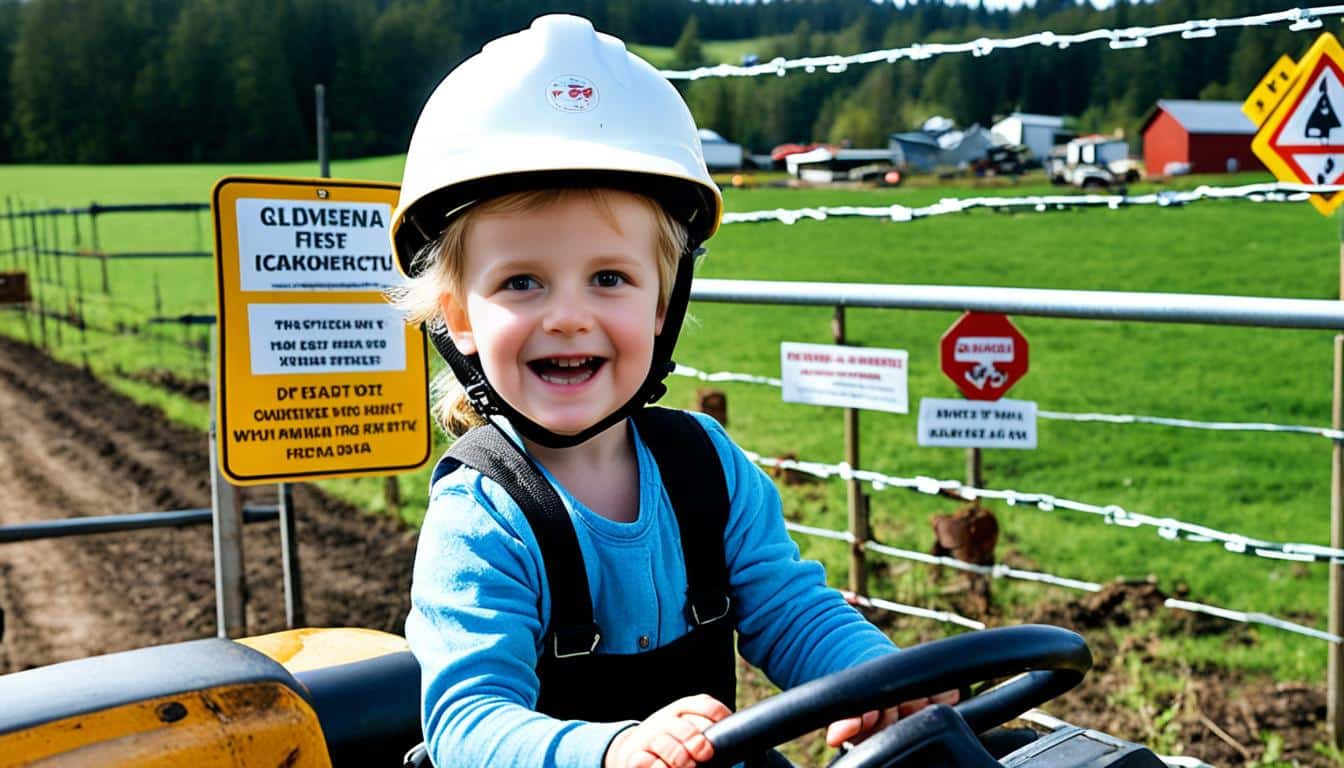
Have you ever thought about the risks on family farms for kids? Farm life offers great chances for children to learn. But, accidents on farms can be more dangerous than illnesses or even drugs. It’s really important to keep kids safe.
Working on a farm isn’t like any other job. It’s dangerous, and many children get hurt or even die every year. Sadly, farms are more risky than mining or construction. To keep kids safe on farms, it is key to keep harmful things away, always watch them, and teach everyone on the farm about safety.
There are about 1.5 million kids who help on U.S. farms. Sadly, 33 of them get hurt every day, and one dies every three days. This shows we must work hard to make farms safer for children.
Keeping kids safe on family farms is vital. There are many dangers like machinery, chemicals, and animals. We must stop farm accidents to protect children’s lives and health.
Kids and teens make up about 20% of farm deaths and get hurt more than adults. In Pennsylvania, half of the farm deaths between 1990 and 1994 were kids. Sadly, a child died every three days from an agriculture incident in the US. Safety rules should cover everything that could harm a child on the farm.
Each year, about 27,000 children in farming families face major injuries. If we include kids on all farms, this number jumps to nearly 100,000. This is why we need to act fast with farm safety.
Kids 13 to 16 might get hurt by machinery, on roads, and with ATVs. Teens 16 to 18 face dangers like adults, including health issues and getting caught in machines. This risk is higher if they’re using drugs or drinking. About 9.3 out of every 100,000 young farmworkers die each year. This shows how much we need better safety and to teach kids more about being safe.
A study connected risks with tasks such as working with animals, chemicals, and using machines. Kids working in “fresh market vegetable operations” often felt pain, and 25% found it too hard to work. We can lower these risks with rules, watching over them, and teaching them how to work safely.
Children face many dangers on farms. They are often not strong enough or wise enough to stay safe. Following farm safety rules can protect them. This makes the farm a safer place for kids.
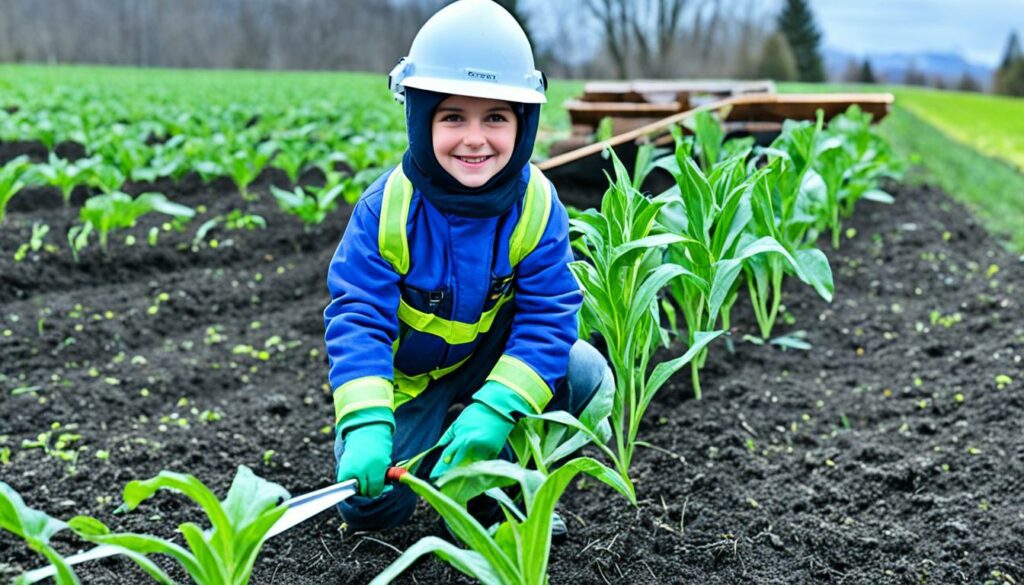
Farms have many risks. These include big machines, animals, and dangerous chemicals. It’s key to show children where they can be and what to avoid. Using safety features on machines helps keep them safe.
From 2011 to 2020, 10% of farm-related deaths were children. Each year, 2 to 3 kids pass away on farms. Machinery and drowning are the main dangers, especially around dams.
Younger kids get hurt playing near tractors. Older ones risk injuries using machinery. Boys are often hurt more than girls. Making sure children don’t ride on machines and use the right equipment helps a lot.
| Cause of Injury | Percentage |
|---|---|
| Tractors/Machinery | 40% |
| Drowning | 30% |
| Falls | 15% |
| Livestock | 10% |
| Other (chemicals, electricity, firearms) | 5% |
Farmers must keep farms safe for kids. Watching over them and updating safety rules are crucial. This way, kids can safely enjoy the farm.
Keeping kids safe on farms means making sure they can’t get to dangerous items. This is key in teaching both rural child safety and farm safety for kids.
Sharp tools and heavy machinery are common causes of child injuries on farms. To lower these risks, keep them in locked places like cabinets or sheds. Make sure these areas are not where kids play. This step helps prevent accidents.
It’s very important to lock away harmful chemicals to avoid farm accidents. These substances must go in locked and high-up places, like cabinets or sheds. Put clear labels and keep children away from them. This is a big part of educating children about farm safety. It avoids poisoning incidents and makes the farm safer for kids.
Keeping an eye on kids on farms is crucial for their safety. If children are watched closely, accidents are less likely to happen. Every year, around 300 kids die on farms, and about 24,000 are badly hurt. This shows how vital it is to always keep an eye on them.
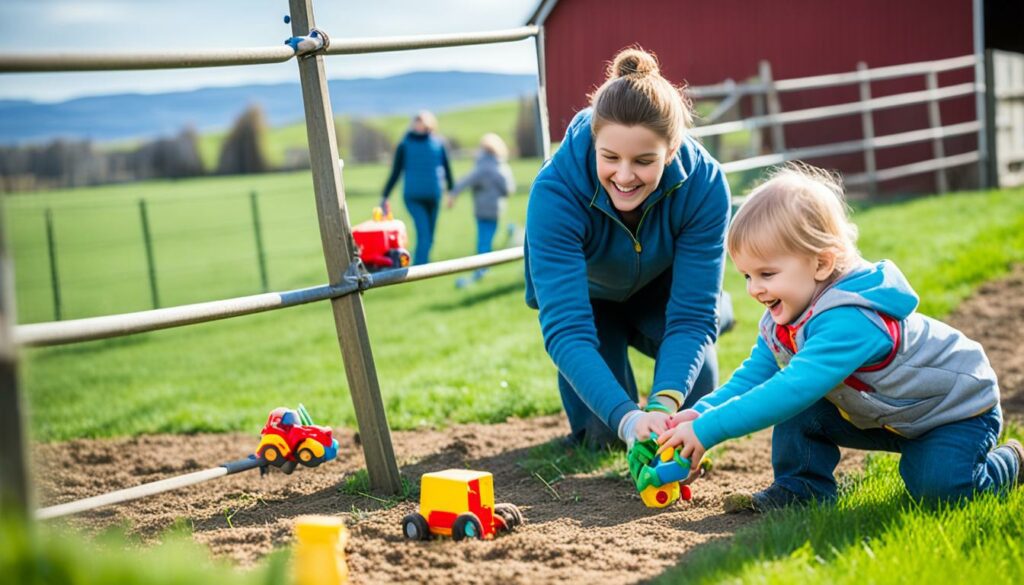
Watching children within view is a key step in farm safety. It prevents them from getting near dangerous places or using risky machinery. In the U.S., about 33 kids a year get seriously hurt on farms. It’s why keeping watch is so important. Plus, 97% of farm families worry about their kids’ farm safety, making supervision the top concern.
Parents aren’t the only ones responsible; farm workers help keep kids safe too. It’s important for everyone on the farm to be alert and trained on farm dangers and where kids are. When both parents and staff look after the children, quick action can be taken in emergencies. This teamwork is key to reducing the chance of kids getting hurt.
It is crucial to have clear and enforceable rules to keep children safe on family farms. There are many agricultural hazards for kids. So, it’s vital to set clear boundaries and follow specific safety guidelines. These rules need to cover places kids can’t go, how to treat animals and machinery, and jobs they should not do. By having children’s farm safety guidelines, we make sure everyone is safer. This reduces the chances of accidents.
It’s also important to make rules that are easy for kids to understand and remember. When kids see that these rules are always applied, they learn to be careful and responsible. This helps to avoid accidents and makes the farm a safer place for everyone. Knowing and following the agricultural hazards for kids helps keep the farm organised and safe.
A sad fact is that 33 children get hurt in farm accidents every day. This shows how badly we need children’s farm safety guidelines. Between 1994 and 2013, there were 389 deaths in farming. This really shows the importance of sticking to safety rules on the farm.
Here are some important rules:
These rules are not only practical but also prevent many dangers. Children’s farm safety guidelines are important. They keep kids safer from many farm dangers. This makes family farms a better and less risky place for children.
| Year | Injuries | Fatalities |
|---|---|---|
| 1994-2013 | – | 389 |
| Daily | 33 | – |
It’s crucial to give kids the right chores on farms. This safeguards them and helps them grow. By understanding what children can do at different ages, we choose tasks carefully. This makes sure they join in safely and learn good things. Encouragement and teaching are very important. They help children feel responsible and start good habits.
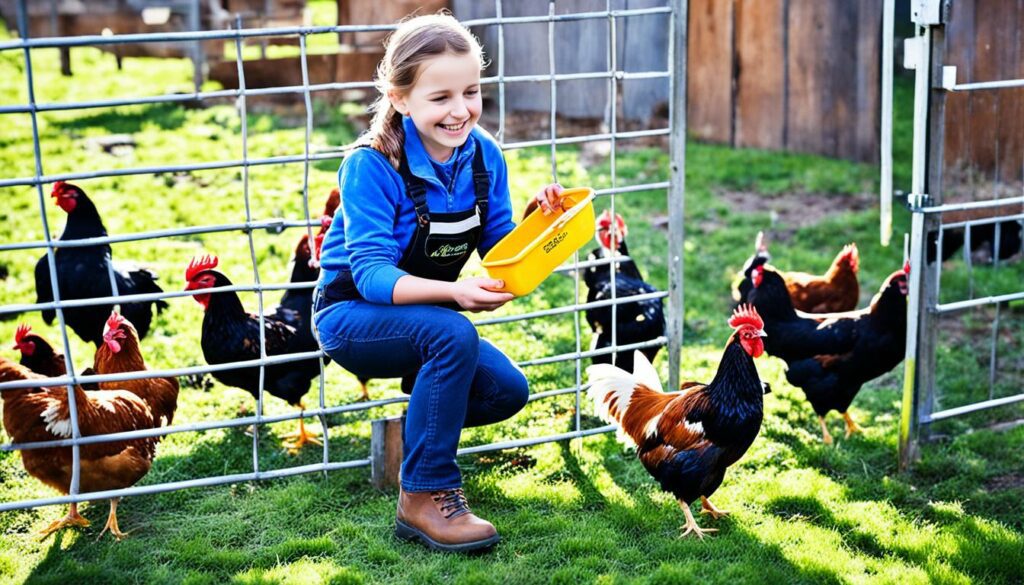
Kids under five can start with easy, fun chores. Chores like collecting eggs, watering plants, or feeding animals are perfect. These tasks make the farm safer for little ones. They also teach important values like hard work and responsibility from a young age.
Older kids and teens can do more. They can handle bigger tasks as they get stronger and smarter. With proper safety training, teens might help with machines or more serious farm work. Doing chores also lets them feel proud and healthier because they move more.
Choosing chores wisely is all about safety and age-appropriate tasks. Young children can do simple yet important jobs:
These simple tasks promote
and help them love the farm.
Teenagers, however, are ready for bigger challenges:
Fostering safety on the farm is top priority. Balancing duty and safety is the key. Making chores fun and educational helps. It teaches kids why each job matters. This way, they learn to respect and love farm life.
Having specific days for tougher farm work helps complete tasks and keeps things organised. It also ensures tasks can be done without rushing, making the farm a safer and happier place.
In conclusion, matching farm chores to kids’ ages improves safety. Guiding them patiently is essential. It keeps them safe while they learn to be reliable and hardworking.
Teaching children about farm safety is vital to reduce risks they face. Kids and teens make up about 20% of all farm deaths. So, it’s crucial to educate them on staying safe. Tools online and fun activities can boost their safety awareness.
There are many farm safety education for kids online. Places like the National Children’s Center for Rural and Agricultural Health and Safety offer learning. They teach children farm safety basics. Online, kids learn how to spot dangers and avoid getting hurt.
Activities are great for teaching kids farm safety. Realistic farm drills help them understand and remember safety rules. For example, acting in emergency drills or learning to use farm tools safely. This hands-on learning shows how important child safety on farms is. It makes sure kids know how to be safe every day.
Using these resources and fun activities can cut down on the 100,000 child farm injuries yearly in the U.S. Kids will learn to make safer choices on the farm. This creates a safe and protected environment for them.
Safety posters and signs are key in teaching kids about farm safety. They show important safety rules in easy-to-understand ways. By placing them where they catch your eye, they help remind everyone about the dangers and how to stay safe.
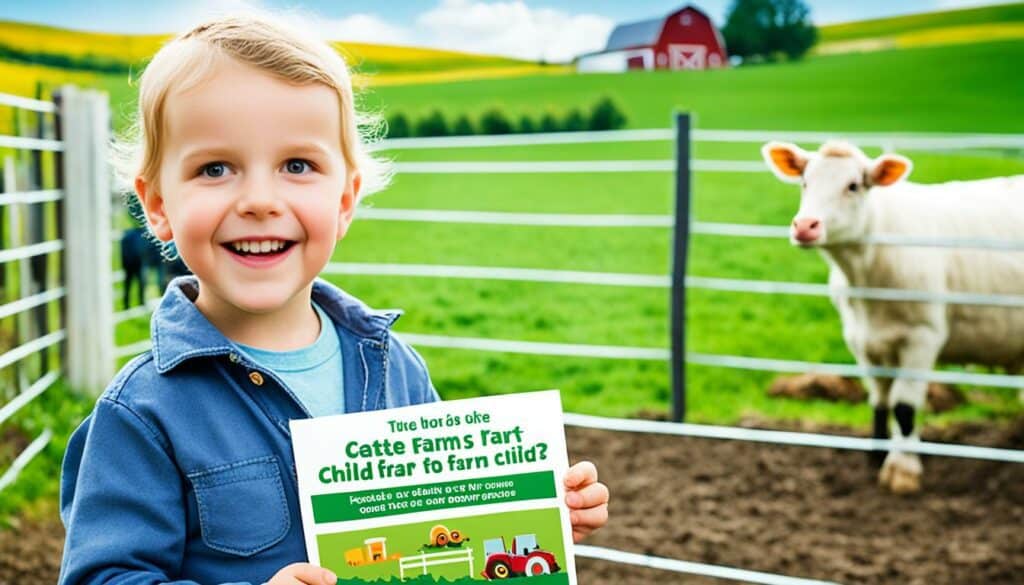
Safety posters work best when put in busy and risky spots. This means near machines, around animals, by chemicals, and water. By placing them here, we remind kids and farm workers to be careful. This helps reduce the 27,000 injuries kids get on farms each year.
Choosing the right images and words on signs helps kids of different ages learn. For example, little ones understand danger with bright colours and simple symbols. As kids get older, they can read and understand more detailed signs. This way, we match the message to what they can understand, making farms safer for everyone.
| Age Group | Developmental Characteristics | Visual Cues and Signage |
|---|---|---|
| Birth-4 Years | Limited understanding, attraction to bright colours | Bright colours, simple symbols |
| 5-7 Years | Increasing comprehension, learning to read | Combining symbols with simple words |
| 8-12 Years | Intermediate reading skills, understanding complex instructions | Symbols with clear text, instructional graphics |
| 13-18 Years | Advanced comprehension, ability to follow detailed instructions | Detailed text, instructional diagrams |
Using safety posters that fit kids’ ages is crucial. It makes the farm safer for children. This approach supports farm safety guidelines, making the farming environment more secure for the young.
Making farms safer and keeping children safe is vital. Safety fences and barriers help a lot. They keep kids away from dangers on the farm.
Putting up strong fences around dangerous places is smart. Places like ponds, sheds, and manure pits need to be off-limits. Farming can be more dangerous than mining or building. Preventing accidents, like drownings or getting trapped, is crucial.
Adding gates and locks boosts farm safety. These are key in controlling who goes where. For example, locked gates around dangerous places reduce risks. They help prevent the leading cause of death on farms, tractor accidents.
Farm safety studies show children are more at risk, especially teens who take more chances. Good fences and barriers are big steps towards safer farms for kids.
It’s really important to keep children safe around farm animals. This is a big part of running a farm well. By following safe methods with animals, we can make sure kids are less likely to get hurt on farms.
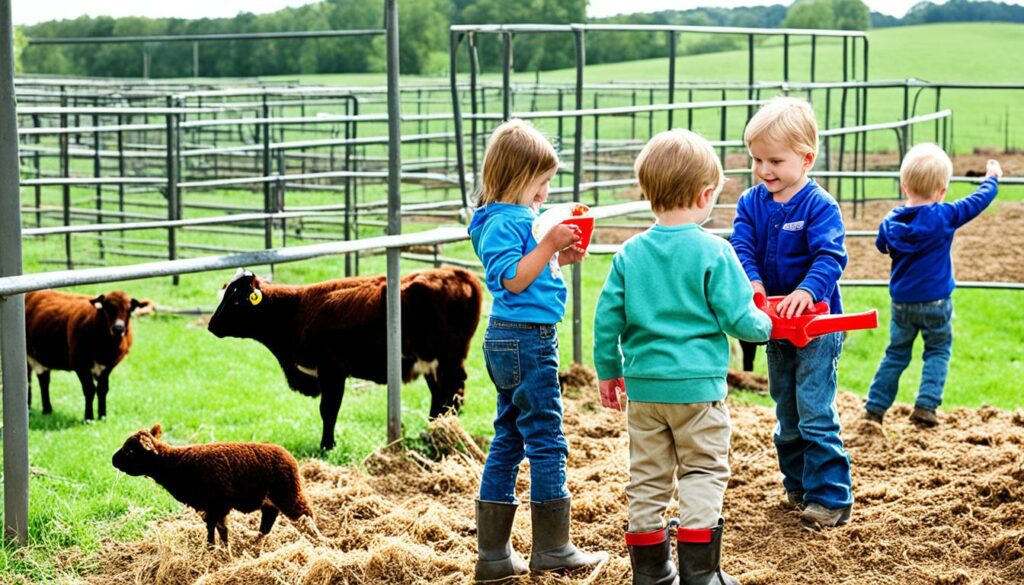
There are a few things we can do to make sure kids are safe from farm animals. We need to teach them to stay a safe distance away, especially when animals are eating. This is because animals can get scared easily.
They can see all around them and might get frightened by sudden moves or loud sounds. This fear can lead them to accidentally hurt someone.
Looking after animals properly and being with kids when they are near the animals is key. Children should wear clothes that won’t easily get stuck in things. This includes not wearing anything shiny that may attract an animal’s interest.
Teaching kids to be gentle and slow when around animals helps keep everyone safe. They should also learn about animal signs to know when an animal might not be feeling good. This helps them avoid getting hurt.
It’s very important that an adult is always there to watch over. If something dangerous might happen, they can step in quickly. This helps keep farms a safe place for children and adults alike.
Keeping the farm’s vehicles safe is key to protecting kids from harm. It’s important to set clear rules for kids around the tractors and machines. Making sure these rules are followed keeps the farm a safe place.
Children must learn safety rules when near tractors and machinery. A key rule is no extra people on the machines. This can help reduce the many accidents that happen.
Kids must also understand the risks of the Power Take-Off (PTO). This part of the machine is quite dangerous. It’s vital for parents and farm workers to make sure children pay attention to these rules. This helps make the farm safer for everyone.
Older children need the right training to safely use and ride farm vehicles. Knowing how these machines work and their dangers makes kids act more responsibly. This training cuts down on accidents.
Kids under 12, for example, shouldn’t handle ATVs with big engines. This shows that there are rules for different ages to stay safe. Good training and following these rules are big parts of preventing accidents on the farm.
Child safety on farms is key, focusing on first aid and being ready for emergencies. Accidents are common, making a good first aid kit and plan essential parts of keeping kids safe. They allow for quick care, which might save a life.
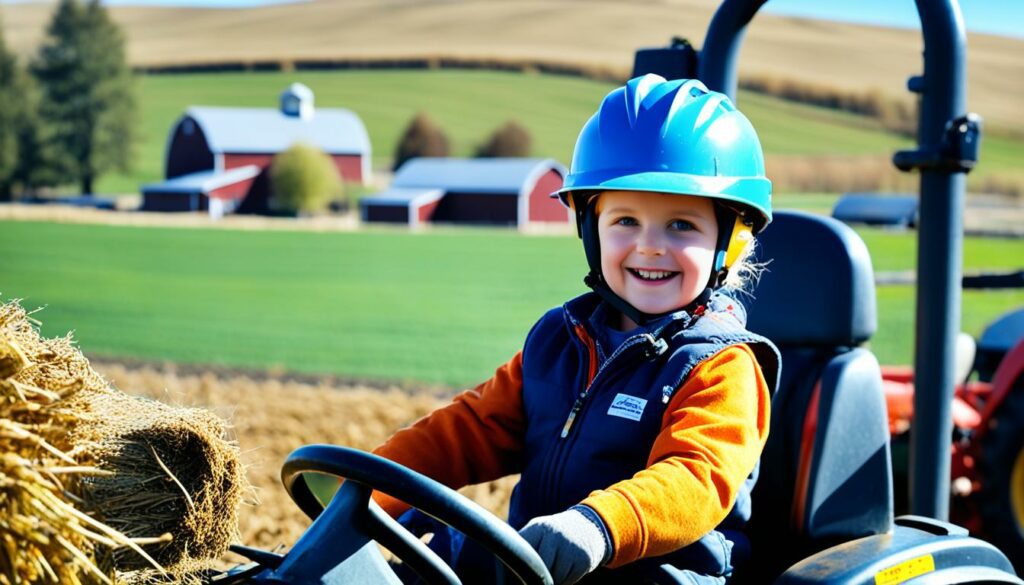
A good farm first aid kit matters a lot. It needs to have tools for many farm injuries, like bites from snakes or spiders. You can get these kits from places such as St John Ambulance, the Australian Red Cross, or local shops. Having different first aid items means you’re ready to treat any injury, making farms safer for kids.
Preparing and running through emergency plans is crucial for child farm safety. You should plan for things like accidents with machines, poison from chemicals, or natural disasters. Using tools for good communication, such as two-way radios or mobile phones, means help can come quickly. It’s also smart to show an Emergency Contact card around, listing important contact numbers, for faster response times.
Everyone on the farm should get first aid training, which groups like the American Red Cross and National Safety Council can provide. Doing practice drills keeps everyone alert. It helps make sure both kids and grown-ups know what to do in an emergency. Regular training and being prepared are key to keeping children safe on farms.
It’s crucial to encourage and reward safe behaviour in children. This helps them follow farm safety rules. By doing this, we reduce the chances of farm accidents a lot. Giving rewards for safety makes children see why these rules are important. It also makes them want to stick to the rules.
Offering incentives works well for kids who obey safety rules. Rewards can be small but meaningful. They show that their effort in staying safe matters. This way, kids learn to take safety seriously and keep at it all the time.
Positive reinforcement is key to making safety a big deal. Praise for following farm safety guidelines is important. It encourages kids to keep up the good work. Also, celebrating safe actions and goals with the family helps a lot. It shows that safety is a team effort and everyone supports it.
Teaching kids to put safety first not only keeps them safe but also helps the whole farming community. These efforts keep farms safe for our children to enjoy. It’s about making safety a natural part of farm life.
| Age Group | Risks |
|---|---|
| 5-9 years | Projects with hand tools, collecting eggs, helping with watering plants and feeding small animals |
| 10-13 years | Entanglement with machinery, hearing loss from noisy equipment |
| 13-16 years | Hearing loss, head and spine injuries from motorcycle accidents, machinery rollovers, roadway accidents |
| 16-18 years | Respiratory illness, hearing loss, muscle and bone injuries, machine rollovers, machinery entanglements, risks of drugs and alcohol |
Keeping children safe on farms is key. Working with outside sources helps farm families. They get the latest info and new ways to make farms safer for kids.
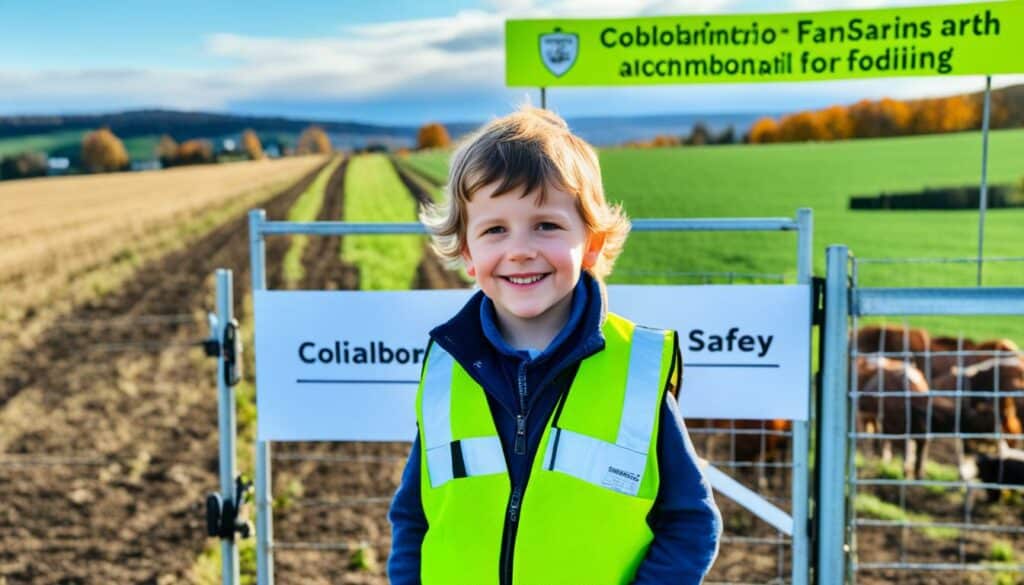
Using national safety advice is crucial. They provide the newest safety tips for children on farms. For example, the National Children’s Centre has many materials and training. This is important because nearly 27,000 kids on farms get badly hurt each year. This shows we need to make farms safer for children.
Joining Lantra’s child safety e-learning course is a wise move. It talks about kids and machinery, staying safe around tools, and why a safety checklist is a must. This learning opportunity helps families make their farms safer.
Talking to other farm families is helpful. It lets everyone share what works to keep children safe. The ‘Farm Secure’ app, made by students and supported by FSP, helps by teaching through quizzes and videos.
Also, a farm safety poster contest from 1 June to 30 June 2023 aims to teach children. It’s for kids in Northern Ireland’s primary and special schools. They get to draw posters about farm safety.
But, the fact that 20% of farm deaths are kids is alarming. This shows we need community efforts. We must share safety resources to protect our children on farms.
Keeping children safe on farms needs a strong, lasting safety plan. Farms are full of dangers, so it’s key to have rules that work now and can be tweaked as needed. These guidelines will look at the dangers kids face and how to keep them safe over time.
It’s vital to have a complete safety plan. This includes rules for using machinery and handling animals. Shockingly, around 27,000 kids are badly hurt on farms every year. This fact shows why we need strict safety rules. Nearly half of the kids who died on farms in Pennsylvania did so while helping with farm tasks.
But, there’s another side to the danger. The farm ‘way of life’ can also be risky. This lifestyle led to as many deaths as farm work. Having detailed safety policies helps lower these dangers. It makes the whole farm a safer place for children.
Farming changes a lot, with new techniques and tools. This means we must always check our safety rules. As new machines and tools come in, we might have to update how we keep kids safe around them. Safety gear is always improving, too.
Going over our safety plans regularly helps us spot where we can do better. For example, we might find that we need new rules about how long kids can be around harmful stuff. With about 100,000 injuries a year on farms, it’s clear we must keep improving safety.
| Age Group | Developmental Characteristics | Common Causes of Injuries/Deaths | Prevention Strategies | Appropriate Work Tasks |
|---|---|---|---|---|
| Under 5 | Limited coordination, supervision required. | Animals, machinery, drowning. | Constant supervision, barriers around hazards. | Feeding small animals, collecting eggs. |
| 5-10 | Improved motor skills, vulnerable to curiosity. | Falls, animal attacks, machinery. | Supervised tasks, safety training. | Simple gardening, feeding animals. |
| 10-15 | Increased strength, overestimate abilities. | Machinery accidents, chemical exposure. | Training on proper equipment use, restricted access to chemicals. | Operating small equipment with supervision, animal care. |
| 15-20 | Enhanced cognitive skills, greater responsibility. | Tractor rollovers, complex machinery incidents. | Extensive training, Rollover Protection Structure (ROPS). | Operating tractors with safety gear, managing livestock. |
Setting up a clear safety review plan boosts child safety on farms. It helps prevent accidents. By being ready to change and always careful, family farms can be safer for kids. This supports their growth and keeps them away from harm.
Keeping children safe on farms is a complex issue. It involves teaching them, preparing ahead, and watching over them. Kids make up about 20 percent of farm deaths and many more injuries. Every year, 27,000 children on family farms get seriously hurt. This number jumps to nearly 100,000 when you count all farms.
In Pennsylvania, there were 210 farm deaths from 1990 to 1994. Half of these deaths were because of work hazards. But, we still don’t have enough evidence to set safe limits for kids on farms. This shows we need to always check and update how we keep kids safe on farms.
Work with others and groups focused on safety can really help keep farming safer for kids. Women in farming often find it hard to look after children and keep the farm safe. The COVID-19 pandemic has made this even harder with more kids on farms. So, making strong, long-lasting safety plans, and checking them often, is key to keeping farms safe for kids.
Children need watching all the time on farms. Keep dangerous things away from them. You should also teach them safety rules. It’s vital to make sure they and any farm workers know what to do in an emergency.
Many children get hurt or die on farms each year. Setting up the right safety steps lowers these risks. This makes farms safer places for kids.
Things like machinery, animals, chemicals, and water are big risks for kids. Knowing these dangers helps us protect children better on farms.
Store tools and sharp things in locked places. Keep poisons locked away too. This stops kids from using things that could harm them.
Keeping an eye on children stops them from going places that are dangerous. It also means quick help in an emergency. Everyone working on the farm must be careful and watch out for kids.
Good, clear rules cut down on accidents. These can include not playing near big machines. Make sure the rules are easy for kids to understand and follow.
Chores should match a child’s age and skills. Little ones can feed small animals. Older kids can do more, like running simple farm tools, once they’ve been shown how.
Groups such as the National Children’s Center for Rural and Agricultural Health and Safety offer help online. They have activities that make learning about farm safety fun and clear.
Putting up posters where kids can see them helps a lot. These posters show children what’s not safe. They help even the youngest understand danger zones.
Fences and gates stop kids from going near risky places. This way, accidents near ponds or machines are less likely.
Know how to handle animals safely and always keep an eye on kids around them. Teach children to be careful and respectful, so they’re less likely to get hurt.
Kids shouldn’t ride on farm vehicles alone. Older ones who can drive these need to learn how safely. These rules help stop vehicle accidents.
First aid kits help treat minor injuries quickly. Knowing what to do in an emergency keeps everyone safe. Regular emergency drills are important to make sure everyone is prepared.
Positive rewards for following safety rules can motivate kids. It helps build a safety-first mindset on the farm.
Linking up with safety groups and other farms means getting the best safety advice. It helps share good safety ideas, making farms safer for children.
Having a clear safety policy that’s always reviewed is key. It makes sure safety stays up to date. This way, children are always well-protected on the farm.